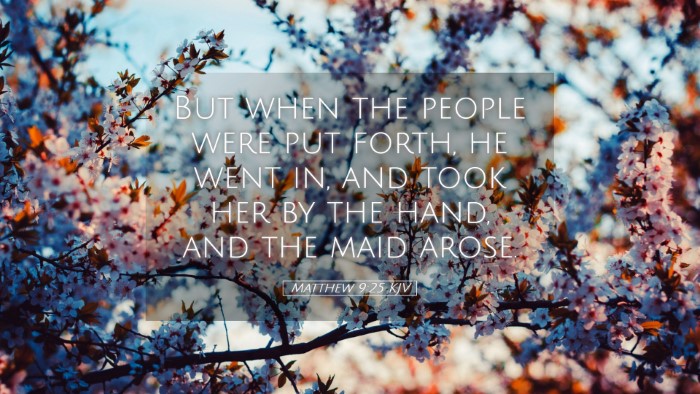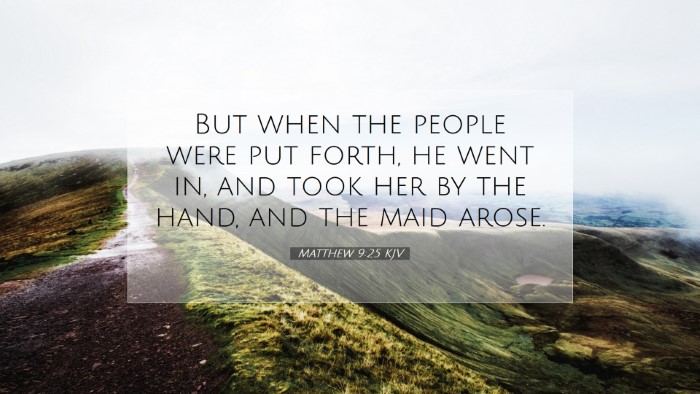Commentary on Matthew 9:25
Matthew 9:25 states: "But when the people were put forth, he went in, and took her by the hand, and the maid arose." This verse captures a miraculous moment in the ministry of Jesus, showcasing His authority over death and His compassion as a healer. The rich insights from various public domain commentaries shed light on this passage.
Contextual Analysis
The context of Matthew 9 reveals a narrative filled with Christ's miraculous works. Preceding this event, Jesus heals a woman with an issue of blood (Matthew 9:20-22) and raises the ruler's daughter from the dead. This passage demonstrates both physical and spiritual restoration, highlighting Christ’s dual role as Savior and healer.
Matthew Henry's Commentary
Matthew Henry emphasizes the importance of faith in this passage. He notes that before Christ performed the miracle, the mourners were put out. This act symbolizes the dismissal of unbelief from the presence of the miraculous. Henry suggests that insightful spiritual leaders must recognize when to separate themselves from doubt and pessimism, as faith is a prerequisite for experiencing Christ's power.
- The Power Over Death: Henry observes that Jesus’ act of taking the maiden by the hand signifies His personal involvement in her resurrection. He argues that this intimate touch illustrates Christ's willingness to reach out to the destitute and helpless.
- Miraculous Healing: The account is a testament to Christ’s authority over life itself. Henry points out that the phrase “the maid arose” underscores the absolute power infused in Christ’s command. She responds without hesitation, illustrating the immediacy of divine intervention.
Albert Barnes' Commentary
Albert Barnes provides a detailed interpretation of the elements involved in this miracle. He remarks that when the crowd laughed at Jesus’ declaration that the girl was not dead but asleep (Matthew 9:24), it portrayed their faithlessness. Barnes highlights that the act of putting these mourners outside demonstrates that ridicule and skepticism cannot coexist with divine activity.
- Physical vs. Spiritual Death: Barnes’ interpretation of the phrase “the maid arose” suggests a metaphorical meaning beyond physical resurrection. He explains that for Christ, death is akin to sleep; a temporary state that He can reverse, demonstrating His authority over spiritual death as well.
- Sign of Authority: Barnes emphasizes that this miracle served as a sign of Jesus’ divine authority, confirming His identity as the Messiah and fulfilling Old Testament prophecies regarding the power of God over death.
Adam Clarke's Commentary
Adam Clarke provides a theological lens through which this miracle can be viewed. Clarke asserts that the act of taking the girl by the hand also conveys a message of hope and restoration to the earthly watchers. The personal touch of Jesus implies His deep compassion, an essential characteristic of His ministry.
- Symbolism of Touch: Clarke elaborates that Christ's touch signifies His divine nature—associating with the deceased without being tainted by death. This interplay of holiness reaching toward corruption reflects the profound mystery of Christ’s incarnation and mission.
- Faith and Resurrection: Clarke also reinforces the notion that faith is a crucial ingredient in miracles. He encourages believers to cultivate an environment where faith, not doubt, reigns, as this passage teaches that faith is a channel for divine power to manifest.
Theological Implications
This passage, thus, offers several theological implications for believers and scholars alike:
- The Efficacy of Faith: The necessity of faith in witnessing miracles is a recurring theme throughout the gospels. The crowd's disbelief stood in stark contrast to Jesus’ power, serving as a reminder that faith opens the door to divine possibilities.
- Christ’s Compassion: Jesus’ actions reveal a God who intimately cares for His creation. The touching of the girl's hand isn’t just an act of healing; it's a demonstration of divine concern—a foundational aspect of Christian theology.
- Life After Death: The notion that Christ can restore life reinforces the broader Christian doctrine of resurrection. This miracle serves as a precursor to the resurrection that believers hope for, where death is not the end, but a transition to eternal life.
Application for Pastors and Theologians
This verse challenges pastors and theologians in their approach to congregational care and the teaching of faith. They are encouraged to:
- Promote a Culture of Faith: Encourage congregants to foster environments where faith flourishes, creating spaces for God's miraculous works to be displayed.
- Emphasize Compassion in Ministry: Model Jesus' compassion in outreach programs, recognizing the physical and spiritual needs of the community.
- Sermons on Resurrection Hope: Incorporate themes of resurrection into sermons, reinforcing the hope that believers have in Christ’s victory over death.
Conclusion
Matthew 9:25 is a profound verse laden with meaning and implications about faith, divine authority, and Christ’s compassionate nature. By examining this passage through the lenses of Matthew Henry, Albert Barnes, and Adam Clarke, we gain a richer understanding of its theological significance and practical application. Each perspective invites us to engage more deeply with our own faith journeys and encourages the church to embody the compassion and authority of Christ.


